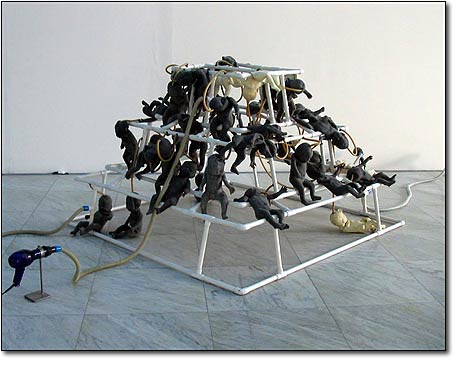Fundación Telefónica,
Mar 10, 2004 - Jun 06, 2004
Santiago , Chile
The End of the Eclipse
by Isidora Correa
From this viewpoint, Jiménez structured the disposition of the works in a single dialogue, where each artist has his own space but at the same time forms part of a joint conception. The way the works are presented seeks to attempt to underline the diversity of both the means of production as well as the personal proposals of participating artists. The exhibit begins with the works of Yolanda Gutiérrez and César Martínez, both Mexican. The first shows us, by imitating Nature, what is really left of her. De las hojas sólo queda el susurro is the title of the work in which the plastified leaves are contained by false vegetable forms which grow on vegetable carbon. The second proposal, Clonación y viceversa, uses the shape of the pyramid, to show replicas of inflatable and deflatable children joined together by a series of air-conveying conduits, thus raising intermittent questions about overpopulation and biological manipulation. For his part, Gustavo Artigas presents documentation on a series of public exhibition space interventions by multiplying his own identity. Duplex, the title of Artiga's work where he relies on himself to strategically show the loss of the limits to the individual. The Colombian, Nadin Ospina, presents his installation Principe de las flores, and examines the problems surrounding the cultural patrimony of the Archeological and Natural History Museum and its connection with the invasive world of entertainment. The Argentine Fabiana Barreda, with a photo-performance series, shows us a body covered by a suit carefully made from the remains of food wrappings. This reminds us of the protective wear used in radioactive and polluted environments. By means of the photographs the author captures the passage of this body through different urban and peripheral locations, resulting in strong tension with the environment. Another Argentine proposal worth noticing is in the hands of Jorge Macchi. This consists of a video projection in which numerous words have been captured from different publicity ads and decontextualized. These isolated words are succesively joined in a text which alludes to the title of the piece, Victima serial. The result is a pretty suggestive game between mass comunication media and the advocate who becomes the victim of his messages. The End of the Eclipse consists of twenty-six installed works, plus a selection of eleven videos, and five other proposals in the nine-country "network" representing Latin America.
Before being presented in Chile, this exhibit was shown in Madrid in September, 2001; at the Museo De Arte Contemporaneo (MARCO) in Monterrey, and at the Museo de Arte Moderno in Mexico City, as well as at the Museo Nacional de Bellas Artes in Buenos Aires, Argentina.
|











